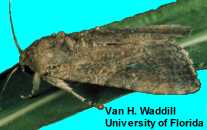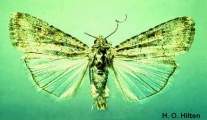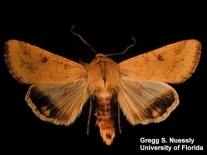Species Specific Trends
Fall
armyworm | Beet armyworm | Diamondback moth | Cabbage looper | Corn earworm
 |
Fall Armworm Fall armworm counts average approximately 50 per wk during the summer months when few vegetable crops are grown in the Everglades Agricultural Area (EAA). While fall armyworm feeds on a wide range of grass and broad leaf plants, the biggest build up of fall armyworm in the EAA is correlated with the sweet corn season. Over 10K acreas are normally grown in the fall and another 25 to 40K ac during the late winter and spring. During these seasons, counts build and peak on 3 to 5 wk cycles, with sustained counts of over 300 per wk. Frequently, fall armyworm trap counts jump up into the range between 600 and 1400 per wk at the cycle peaks. Fall armyworm counts are usually good indicators of rest of crop season. High fall counts are usually followed by high spring counts, and low fall counts usually indicate fall armyworm numbers will be lower than usual during the spring months. |
 |
Beet Armyworm Numbers of beet armyworms in traps build to their highest levels during a 100 to 150 day period from late March through mid June. Similar to fall armyworm counts, beet armyworm counts rise and fall on 3 to 5 wk cycles during this period. However, the amplitudes are much lower than those for FAW and run between 250 and 400 moths per wk. Another smaller beet armyworm population increase normally occurs from mid August through October. While the spring population increase occurs during the mid to late leafy vegetable season for south Florida, the late summer and fall increase begins before the bulk of the planting. This latter increase is probably more related to activity on late summer weeds than on early planted crops. |
 |
Diamondback
Moth Diamondback moth in the EAA is usually a serious pest from mid winter through spring. Trap counts routinely jump from near 0 to between 20 and 50 per week by the second wk in February. They remain elevated until the end of May when they return to near 0. Diamondback moth numbers can again increase in mid fall through early winter, but such an increase is a poor indicator of activity for the remainder of the leafy vegetable season. Diamondback moth begins to build on winter weeds such as mustard before moving into the green, red and asian cabbages grown predominately during winter and early spring seasons. Diamondback moth populations on the eastern fringes of the EAA and further east toward the coast are much larger and begin to increase sooner than those in the central EAA. This is probably due to near year round asian cabbage production and oversummering on watercress. |
| Cabbage
Looper Cabbage looper trap counts vary greatly from year to year in the EAA. Counts rarely reach over 50 per wk and frequently range from 0 to 5. They can be a serious pest of leafy vegetable crops. Counts tend to be higher in areas where broccoli, cauliflower and cabbage are grown year round. |
|
 |
Corn Earworm While corn earworm is primarily a pest of sweet corn in the EAA, pheromone trap counts of the insect do not necessarily correspond with the corn season. In 1990 we experienced a great increase in counts to over 250 per week in mid July, but the numbers were back down below 5 per wk by the time the corn season started. This pest can be found in most seasons in most fields, but is considered much less important than fall armyworm in EAA corn. Trap counts during the last three years have never exceeded 5 per wk, even during the height of the corn season. |
Back to Pheromone Trap Data Home page